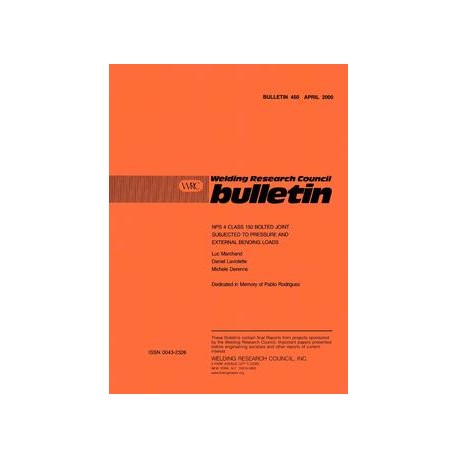Cart
0
Product
Products
(empty)
No products
To be determined
Shipping
$0.00
Total
Product successfully added to your shopping cart
Quantity
Total
There are 0 items in your cart.
There is 1 item in your cart.
Total products
Total shipping
To be determined
Total
New
Reduced price!
 View larger
View larger
 View larger
View larger
WRC 450
M00009609
New product
WRC 450 NPS 4 Class 150 Bolted Flanged Joints Subjected To Pressure And External Bending Loads
Bulletin / Circular by Welding Research Council, 2000
L. Marchand, D. Laviolette, M. Derenne
In stock
More info
Full Description
Dedicated in Memory of Pablo RodriguezThis report presents the results of two experimental pilot studies that investigate the effect of external bending moments on the behavior of two types of ASME NPS 4 in. Class 150 bolted flanged joints: one with weld neck flanges, and one with lap joint flanges. A test rig has been specifically designed to submit the flanged joints to pure bending moments. During the tests, the joint leak rate, the gasket contact stress distribution, the bolt loads, and the flange rotations were recorded as a function of the bending moment applied. The flanged joints were tested under three different initial bolt stress levels: 25, 37.5 and 50 ksi (172, 259 and 345 Mpa). A single type of gasket was used throughout the tests, an NBR/asbestos sheet having an initial thickness of 1/16 in. (1.6 mm). The analysis of the leak rates of the two types of flanged joints during the tests shows that the bending moment has a relatively small effect on the tightness of the joints. It was also found that the joint better resists bending moment loading when a high initial bolt load is used during the assembly. However, substantial bolt load relaxation can result from the application of a bending moment especially in the case of weld neck flanges assembled with a low initial bolt stress of 25 ksi. Bolt load relaxation has been linked to the permanent deformation of the gasket caused by the additional compressive stress applied locally to the gasket by the bending moment. If the relaxation of the bolt loads is sufficiently high, a gross leakage condition can occur when the joint is subjected to a reverse bending moment loading. In some of the test performed, the gasket contact stress distribution was measured at four locations with a foil sensor placed directly under the gasket. In the weld neck flange the gasket stress distribution varies somewhat like the longitudinal stress in a hollow cylinder subjected to a bending moment. In the lap joint flange the gasket stress distribution is more intricate. The stress variation across the gasket width was also analyzed. In the weld neck flange, the stress seems to be uniform across the gasket width, while in the lap joint flange a highly stressed zone exits at the outside diameter of the gasket. The replacement of the bending moment effect by an equivalent internal pressure in the calculation of the minimum gasket contact stress was investigated. From a comparison with the available test results, it appears that this method will give conservative results. However, this could be too simplistic for accurate joint tightness calculations, since, this method does not take into account the effect of the flange rigidity on the gasket stress distribution.

